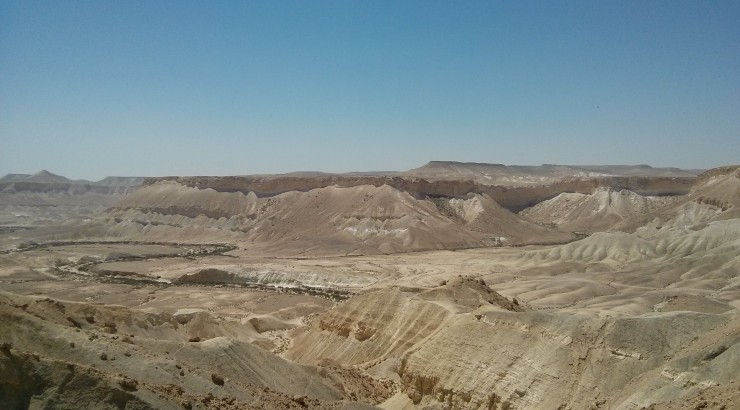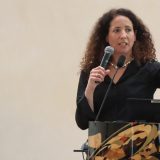Conference in the Wild
June 27, 2014
Written By Assistant History Professor Shira Klein
When I heard that the next Association for Israel Studies conference was going to be in Sede Boqer, a kibbutz in southern Israel, all I could think of was, “how on earth am I going to get there?”
Israel is a small country – about the size of New Jersey – but its south is a desert expanse, with not much transportation connecting it to the bustling urban centers of Tel Aviv and Jerusalem. Sede Boqer is a 45-minute drive from the nearest city, Beer Sheva. The road winds through arid countryside, dotted with Bedouin encampments, camels, and herds of goats.
The conference participants arrive at 9 a.m. The desert is all around us, a sea of sand and rocks and sparse plants. Getting off the bus, we find ourselves at the top of a mountain range, with dry riverbeds – wadis – winding through the valley below.
We are at Midreshet Ben-Gurion, a branch of Ben-Gurion University in Beer Sheva. David Ben-Gurion was Israel’s first Prime Minister, from 1948 to 1963. When he retired from public life, he moved to the remote kibbutz of Sede Boqer and worked on an 11-volume book of Israel’s early history.
It’s fitting that Ben-Gurion’s home was chosen to host the
Association for Israel Studies
. Every summer, the AIS brings together scholars to share their academic research on Israel. Topics range from 19th-century Ottoman Palestine, to the present-day Arab-Israeli conflict, to relations between Israel and the Jewish world, to religious divides in Israeli society. A quick glance at the
program
shows the speakers come from all walks of life: Arabs and Jews from Israel, scholars from the United States and Europe, historians, sociologists, anthropologists, and literary scholars.
My panel focuses on the Yishuv, literally “settlement” in Hebrew, referring to the Jewish population in Ottoman and British Palestine prior to Israel statehood in 1948. My paper is entitled “Italian Jews and the Yishuv” and explores the changing attitude of Italian Jews towards the Yishuv in the early 20th century. There were some 35,000 Jews in Italy in 1900, and few of them showed any interest in Jews living in Palestine. That changed with time. Following World War II, which was calamitous for Europe’s Jews, support for the Yishuv became a strong feature of Italian Jewish culture. My fellow panelists are from the University of Haifa and from the University of Colorado, Boulder.
In between panels, we step outside – not for long as it’s 95 degrees in the shade – and see a couple of Nubian ibexes, desert-dwelling goats, who stop grazing to peer at us. Though the Negev has the reputation of being a barren land, it’s actually teeming with wildlife. According to Wikipedia, there are only 1,200 Nubian ibexes in the wild, so we feel lucky to get a glimpse. One comes particularly close, greeting us with a curious stare.

The Nubian Ibex is a desert-dwelling goat. It lives in dry mountainous terrains like Israel’s Negev region.
The panels have finished for the day. As we get on the bus back to Tel Aviv, a local passerby invites us to return in winter. “That’s when the flowers bloom,” she says. “It’s a beautiful sight: narcissus, sand lilies, irises.” We promise to come back.





